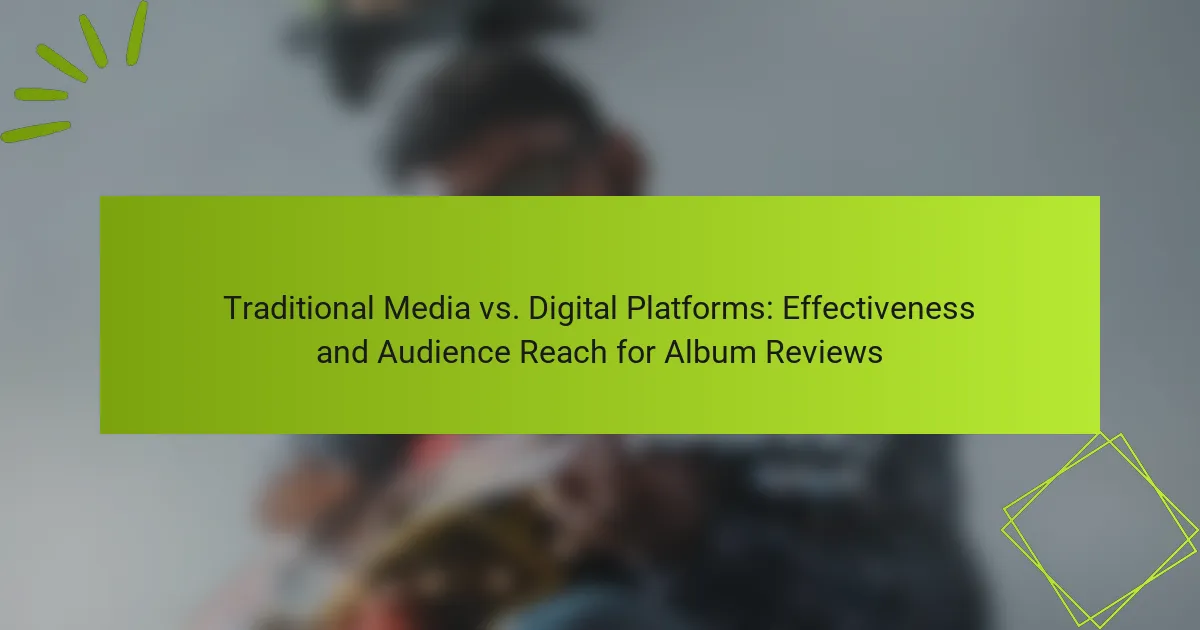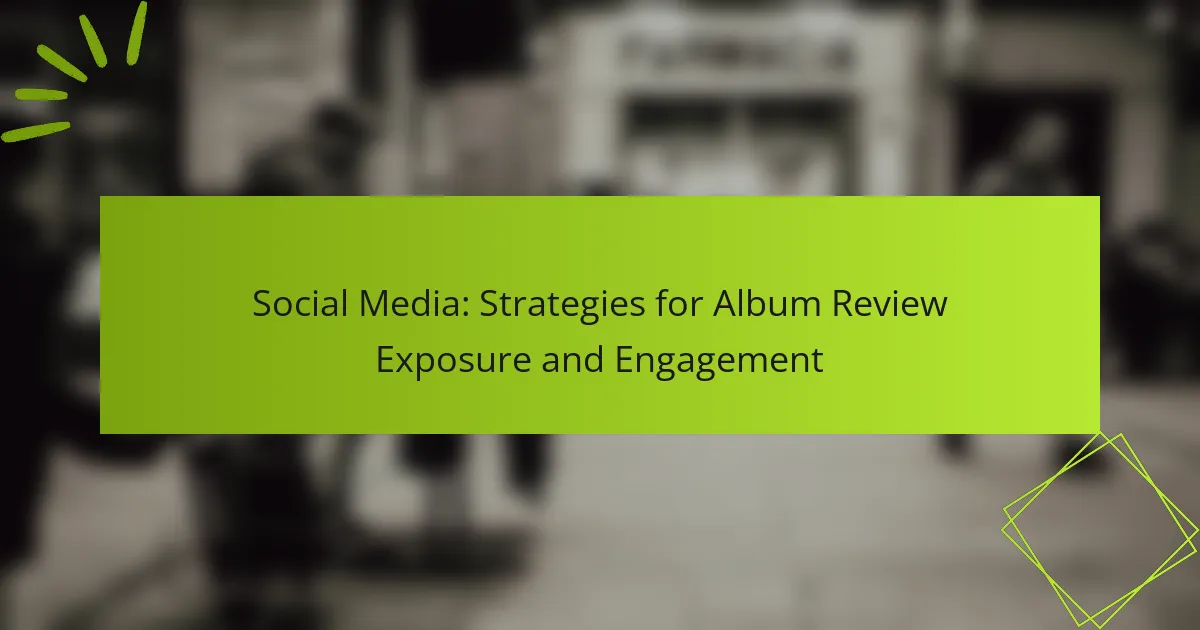Music blogs play a vital role in enhancing audience engagement by serving as interactive platforms where fans can connect with artists and each other. By implementing best practices such as consistent posting and SEO optimization, these blogs can significantly increase their reach and foster a thriving community around music. Additionally, analytical tools allow bloggers to measure their impact and refine their strategies for greater visibility and connection with their audience.
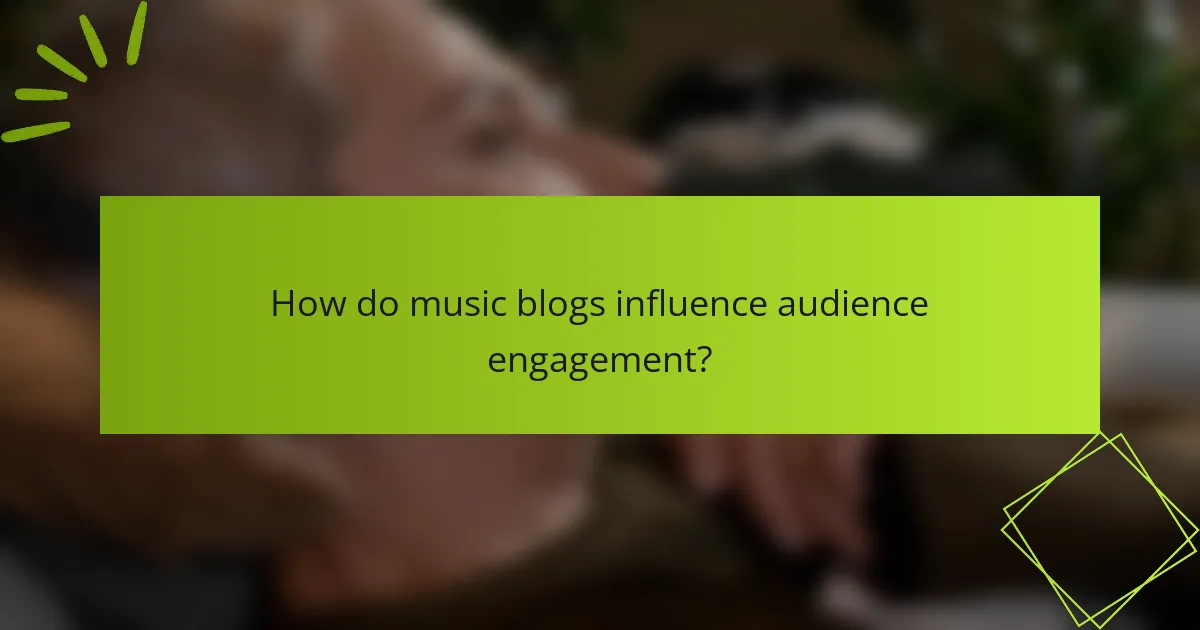
How do music blogs influence audience engagement?
Music blogs significantly enhance audience engagement by providing a platform for interaction, sharing, and collaboration. They create a space where fans can connect with content, artists, and each other, fostering a community around music.
Increased interaction through comments
Comments sections on music blogs allow readers to express their opinions, ask questions, and engage in discussions about the content. This interaction not only builds a sense of community but also encourages more readers to participate, as they see active conversations happening.
Bloggers can enhance this engagement by responding to comments, which invites further dialogue and makes readers feel valued. Setting up comment moderation can help maintain a positive environment, ensuring discussions remain constructive.
Social media sharing boosts visibility
When music blogs share content on social media, it significantly increases visibility and reach. Readers often share their favorite posts, which can lead to exponential growth in audience size as new users discover the blog through their networks.
To maximize this effect, bloggers should include social sharing buttons on their posts and create engaging, shareable content. Visual elements like images and videos can enhance shareability, making posts more appealing on platforms like Instagram and Twitter.
Collaborations with artists enhance reach
Collaborating with artists allows music blogs to tap into their fan bases, creating a mutually beneficial relationship. When an artist features on a blog, their followers are likely to engage with the content, increasing traffic and interaction.
To effectively collaborate, bloggers should seek out artists whose music aligns with their audience’s interests. Offering exclusive interviews, behind-the-scenes content, or guest posts can attract more readers and deepen engagement with both the blog and the artist’s work.
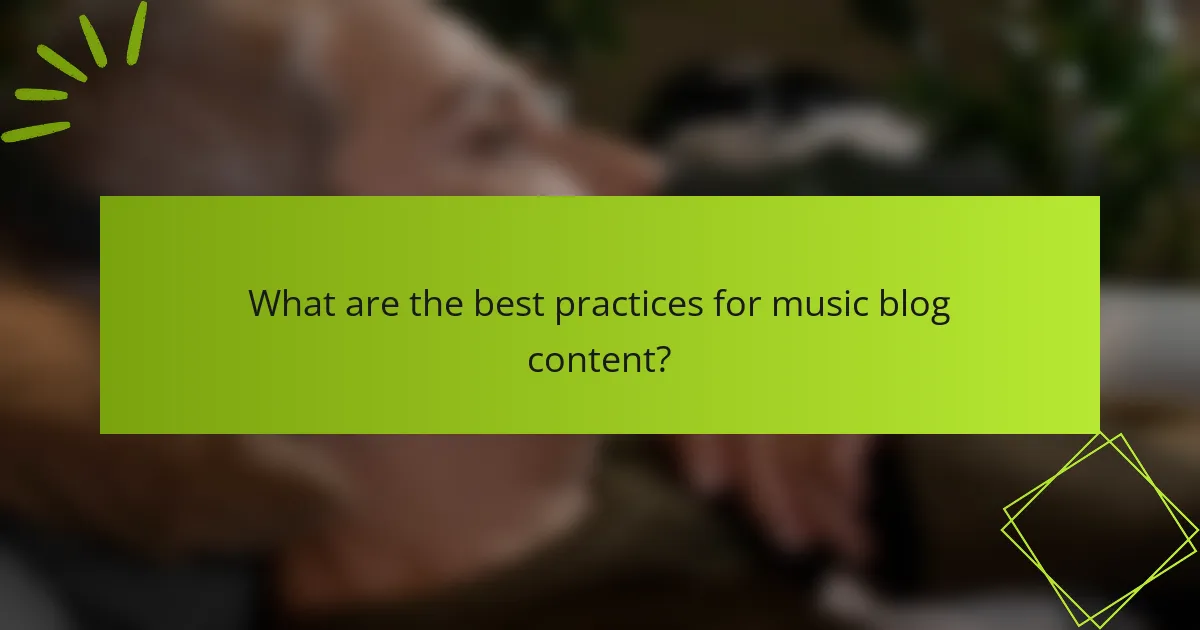
What are the best practices for music blog content?
Effective music blog content hinges on a few best practices that enhance engagement and reach. Consistent posting, high-quality multimedia, and SEO optimization are crucial for attracting and retaining an audience.
Consistent posting schedule
Maintaining a consistent posting schedule is vital for keeping your audience engaged. Aim for at least one new post per week to build anticipation and encourage regular visits. Consider using a content calendar to plan and track your posts.
Consistency helps establish your blog as a reliable source for music news and reviews. Avoid long gaps between posts, as this can lead to decreased interest and traffic.
High-quality multimedia integration
Incorporating high-quality multimedia elements, such as images, videos, and audio clips, can significantly enhance your music blog’s appeal. Use vibrant images and engaging videos to complement your written content, making it more dynamic and shareable.
Ensure that all multimedia is optimized for fast loading times and mobile compatibility. This is crucial, as many users access content on their smartphones. Aim for a balance between text and multimedia to cater to diverse audience preferences.
SEO optimization for discoverability
SEO optimization is essential for improving your music blog’s visibility in search engines. Focus on using relevant keywords naturally throughout your content, including in titles, headings, and meta descriptions. Tools like Google Keyword Planner can help identify effective keywords.
Additionally, consider optimizing images with alt text and ensuring your site is mobile-friendly. Regularly updating content and acquiring backlinks from reputable sites can further enhance your blog’s search engine ranking.
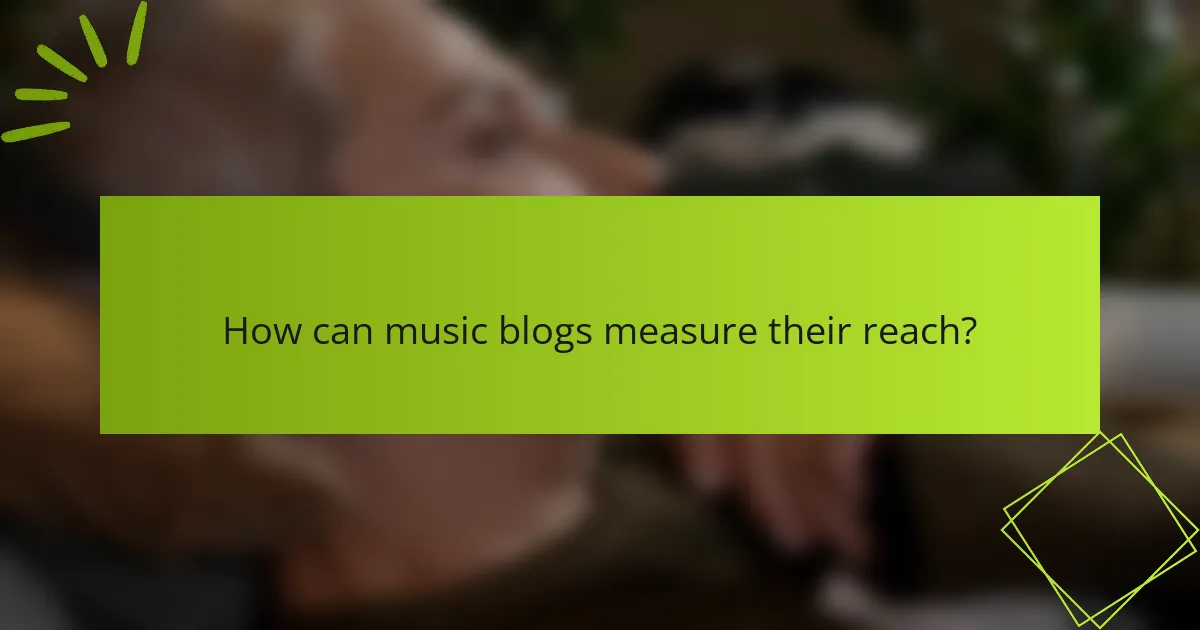
How can music blogs measure their reach?
Music blogs can measure their reach through various analytical tools and metrics that provide insights into audience engagement and content performance. By utilizing these methods, bloggers can better understand their audience and refine their strategies to enhance visibility.
Analytics tools like Google Analytics
Google Analytics is a powerful tool that allows music blogs to track website traffic, user behavior, and engagement metrics. By setting up tracking codes, bloggers can monitor page views, session duration, and bounce rates, which help gauge how effectively content resonates with readers.
To get started, create a Google Analytics account and integrate it with your blog. Focus on key performance indicators (KPIs) such as unique visitors and referral sources to identify which content drives the most traffic.
Social media engagement metrics
Social media platforms provide valuable metrics that reflect how well content is received by audiences. Metrics such as likes, shares, comments, and follower growth can indicate the effectiveness of posts and overall brand engagement.
Utilize built-in analytics tools on platforms like Facebook, Instagram, and Twitter to track these metrics. Regularly assess which types of posts generate the most interaction and adjust your content strategy accordingly to maximize reach.
Audience surveys for feedback
Conducting audience surveys is an effective way to gather direct feedback from readers about their preferences and interests. Surveys can reveal insights into what content resonates most, helping bloggers tailor their offerings to better meet audience needs.
Consider using tools like Google Forms or SurveyMonkey to create and distribute surveys. Keep questions concise and focused, and offer incentives for participation to increase response rates. Analyze the results to identify trends and make informed decisions about future content.
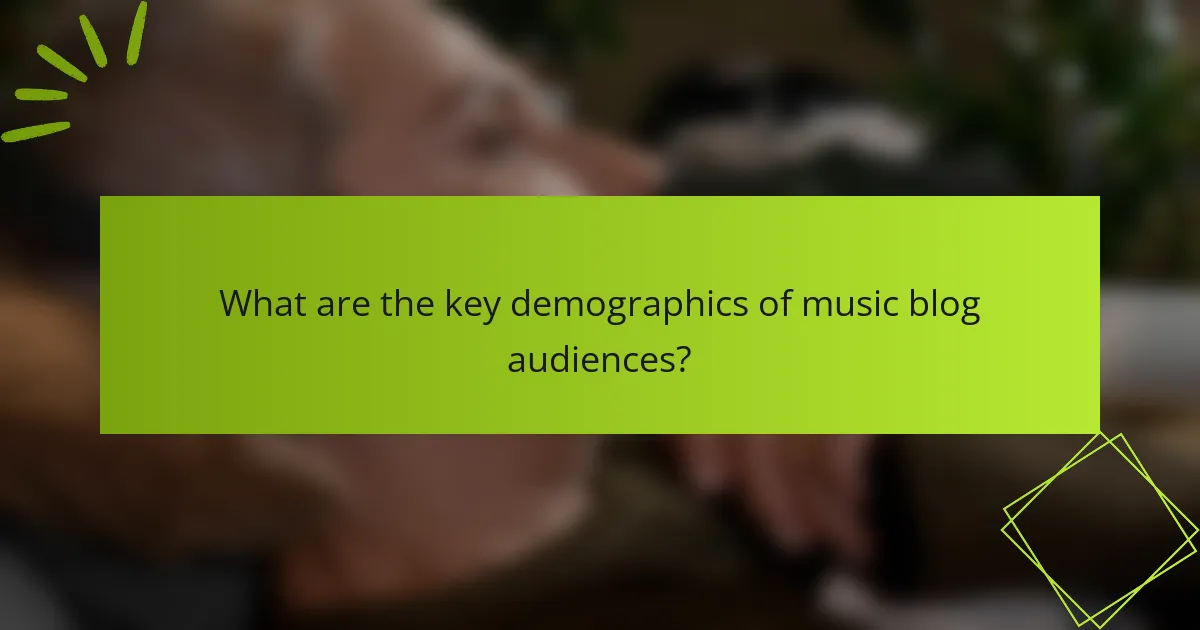
What are the key demographics of music blog audiences?
The key demographics of music blog audiences primarily consist of young adults aged 18 to 34, with a strong presence in urban areas. These audiences are often characterized by their diverse musical interests and active engagement with online content.
Age groups: 18-34 dominate
The majority of music blog readers fall within the 18-34 age range, making them a crucial demographic for music-related content. This group is typically tech-savvy and frequently seeks out new music trends, reviews, and artist interviews.
Younger audiences are more likely to engage with blogs that feature interactive elements, such as playlists or comment sections, which enhance their experience and connection to the music community.
Geographic distribution in urban areas
Music blog audiences are predominantly located in urban areas, where access to live music events and cultural hubs is more prevalent. Cities often serve as melting pots for various music genres, attracting a diverse readership.
This urban concentration allows music blogs to tap into local scenes and promote artists who may not yet have mainstream recognition, fostering a sense of community among readers and musicians alike.
Interests in specific music genres
Readers of music blogs often have varied interests in specific genres, including pop, hip-hop, rock, and electronic music. These preferences can influence the type of content that resonates most with audiences, such as album reviews or genre-specific playlists.
Understanding the interests of the audience can help bloggers tailor their content, ensuring it aligns with the tastes of their readers. For example, focusing on emerging artists in popular genres can attract more engagement and shares among fans.

What tools can enhance music blog performance?
To enhance music blog performance, utilizing the right tools can significantly improve content management, audience engagement, and visual appeal. Key tools like WordPress, Mailchimp, and Canva each serve distinct purposes that collectively boost a blog’s effectiveness.
WordPress for content management
WordPress is a powerful platform for managing and publishing blog content. It offers a user-friendly interface, making it easy for bloggers to create posts, manage comments, and organize media. With thousands of plugins available, you can customize functionality to suit your blog’s specific needs.
Consider using SEO plugins like Yoast to optimize your content for search engines, which can increase visibility and attract more readers. Regularly updating your WordPress themes and plugins ensures your site remains secure and performs well.
Mailchimp for email marketing
Mailchimp is an effective tool for managing email marketing campaigns, allowing you to connect directly with your audience. You can create newsletters, automate email sequences, and segment your audience based on their interests, which helps in delivering targeted content.
To maximize engagement, consider sending regular updates about new blog posts, exclusive content, or upcoming events. Aim for a consistent schedule, such as bi-weekly or monthly, to keep your audience informed without overwhelming them.
Canva for graphic design
Canva is an intuitive graphic design tool that helps you create visually appealing images for your blog and social media. With a wide range of templates and design elements, you can easily produce graphics that align with your blog’s branding.
When designing, focus on maintaining a cohesive style across all visuals to enhance brand recognition. Use Canva’s collaboration features to involve team members in the design process, ensuring that your graphics resonate with your target audience.
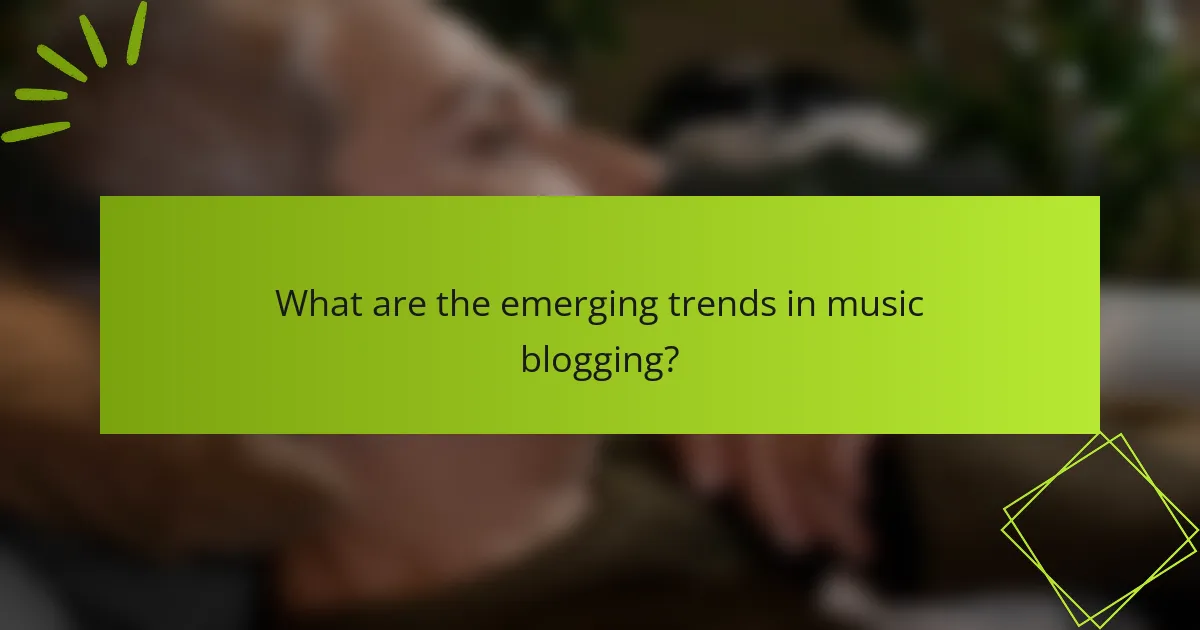
What are the emerging trends in music blogging?
Emerging trends in music blogging include the use of artificial intelligence to create personalized content and a growing focus on niche genres to engage targeted audiences. These trends reflect the evolving landscape of digital media and the need for bloggers to adapt to changing consumer preferences.
Integration of AI for personalized content
The integration of AI in music blogging allows for the creation of tailored content that resonates with individual readers. By analyzing user behavior and preferences, AI can suggest articles, playlists, or even concert recommendations that align with a reader’s taste.
For example, platforms like Spotify utilize algorithms to curate personalized playlists, and similar approaches can be applied in music blogs. This not only enhances user engagement but also increases the likelihood of repeat visits and shares.
However, bloggers should ensure that AI-generated content maintains a human touch. Over-reliance on automation can lead to a lack of authenticity, which may alienate dedicated readers.
Focus on niche genres for targeted audiences
Focusing on niche genres allows music bloggers to cater to specific audiences, fostering a loyal community. By concentrating on less mainstream styles, such as indie folk or underground hip-hop, bloggers can attract dedicated fans who are often underserved by larger platforms.
To effectively engage these audiences, bloggers should create content that dives deep into the genre’s history, key artists, and emerging trends. This could include interviews with local musicians, reviews of underground albums, or coverage of niche music festivals.
Additionally, leveraging social media platforms that cater to specific music communities can enhance reach. Engaging with followers through polls, discussions, and exclusive content can further solidify a blog’s position within its niche.


